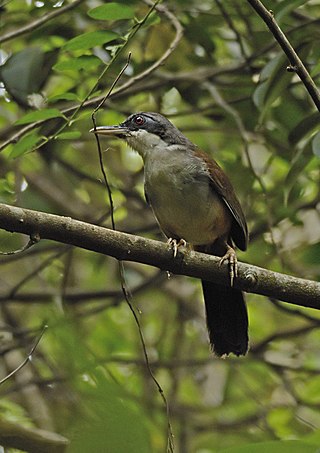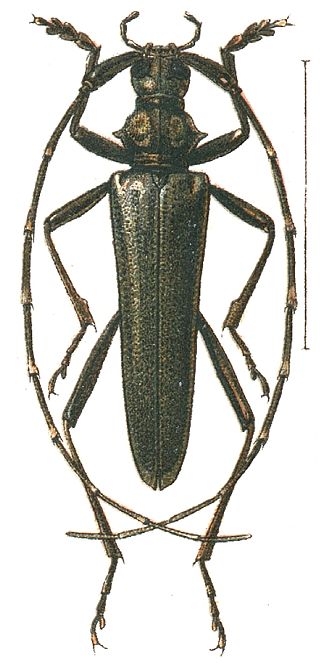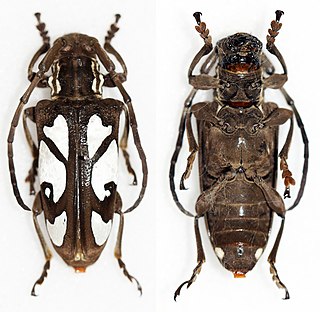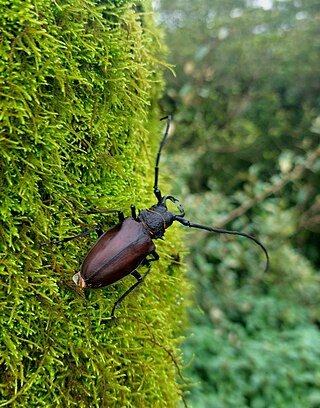
The longhorn beetles (Cerambycidae), also known as long-horned or longicorns, are a large family of beetles, with over 35,000 species described.

Myxophaga is the second-smallest suborder of the Coleoptera after Archostemata, consisting of roughly 65 species of small to minute beetles in four families. The members of this suborder are aquatic and semiaquatic, and feed on algae.

Francis Walker was an English entomologist. He was born in Southgate, London, on 31 July 1809 and died at Wanstead, England on 5 October 1874. He was one of the most prolific authors in entomology, and stirred controversy during his later life as his publications resulted in a huge number of junior synonyms. However, his assiduous work on the collections of the British Museum had great significance.

The Himalayan quail or mountain quail, is a medium-sized quail belonging to the pheasant family. It was last reported in 1876 and is feared extinct. This species was known from only 2 locations in the western Himalayas in Uttarakhand, north-west India. The last verifiable record was in 1876 near the hill station of Mussoorie.

The large-billed reed warbler is an Old World warbler in the genus Acrocephalus. The species has been dubbed as "the world's least known bird". It was known from a single specimen collected in India in 1867 and rediscovered in the wild in Thailand in 2006. The identity of the bird caught in Thailand was established by matching DNA sequences extracted from feathers; the bird was released. After the rediscovery in the wild a second specimen was discovered amid Acrocephalus dumetorum specimens in the collections of the Natural History Museum at Tring. A breeding area was found in Afghanistan in 2009 and studies in 2011 pointed to its breeding in Kazakhstan and Tajikistan. One bird was found in the Baikka Wetland in Srimangal, Bangladesh on 7 December 2011.

The Wayanad laughingthrush is a species of laughingthrush in the family Leiothrichidae. It is endemic to the Western Ghats south of Goa in India. These laughingthrushes move in groups in dense forests, producing loud calls but tend to be hard to spot in the undergrowth. They have brown upperparts, a white throat, a broad black mask through the eye and a heavy bill with pale yellow on the lower mandible. Despite the name, derived from the Wayanad region, this species has a wider range than the four other south Indian species of laughingthrush that are restricted to the higher elevation hills.

The Disteniidae are a small family of beetles in the superfamily Chrysomeloidea, traditionally treated as a group within the Cerambycidae.

Narycius opalus is a flower chafer beetle that is endemic to the Western Ghats of India. It is the sole species in the genus. The adult male has a prominent projection on the head, while the female has a much shorter horn. This structure is probably the result of sexual selection, as in similar beetles. The adult beetle is shiny iridescent rose ranging to green, with intermediates.

The Trictenotomidae are a small family of beetles in the superfamily Tenebrionoidea, containing fifteen species in two genera. Most species are found in the Oriental realm where they live in montane forest habitats. The family is considered, based on larval characters as well as sequence-based studies, to be closely related to the Salpingidae.

The Brachypsectridae are a family of beetles commonly known as the Texas beetles. There are only two extant genera, Brachypsectra and Asiopsectra. Brachypsectra has a cosmopolitan distribution, mostly in arid regions, while Asiopsectra is found in Central Asia and the Middle East.

Parevander xanthomelas is a species of beetle in the family Cerambycidae. It was described by Félix Édouard Guérin-Méneville in 1844, and has been classified in the genus Parevander since the circumscription of that genus by Per Olof Christopher Aurivillius in 1912.

Calothyrza margaritifera is a species of beetle in the family Cerambycidae. It was described by John O. Westwood in 1848 in his "The Cabinet of Oriental Entomology" as Phryneta margaritifera.

Merogomphus longistigma is a species of large dragonfly in the family Gomphidae. It is endemic to the forest streams of Western Ghats of India.
Linda rubescens is a species of beetle in the family Cerambycidae. It was described by Frederick William Hope in 1831. It is known from Nepal, Bhutan and India.

Zonopterus is a genus of beetles in the family Cerambycidae. Like most members in the tribe Callichromatini, species in the genus are brightly coloured with bands across the elytra. Most species in the genus are restricted to Southeast Asia with one species occurring in the Western Ghats of South Asia which is closely related to the type species Zonopterus flavitarsis from the eastern Himalayas. The genus was named by Frederick William Hope using the Greek roots ζώνη for belt describing the insect as "belted winged".

Stromatium barbatum is a species of beetle in the family Cerambycidae. This species is native to the Oriental region. It has been recorded in mainland India, the Andaman Islands, Myanmar, Sri Lanka, Mauritius, Réunion and Seychelles. This species has also spread to continental Africa and Madagascar.

Pachylocerus crassicornis is a species of long-horned beetle found in Peninsular India known from Chota Nagpur south to Kerala.
James Clark Molesworth Gardner was a British entomologist who worked on the systematics of insects, particularly forest insects, while employed in the Indian Forest Service at the Forest Research Institute, Dehra Dun in India.

Coptocercus crucigerus is a species of beetle in the family Cerambycidae, first described by Frederick William Hope in 1842 as Stenochorus cruciger, from a specimen collected in Port Essington (Darwin). In 1929, Herbert James Carter assigned the species to the genus Coptocercus, and also synonymised it with Phoracantha politaPascoe, 1863.

Priotyrannus mordax is a species of long-horned beetle in the subfamily Prioninae endemic to the forests of southern India.



















